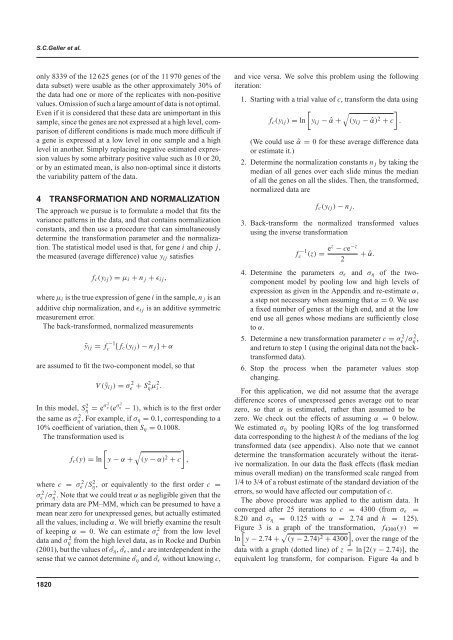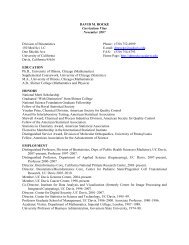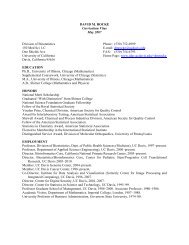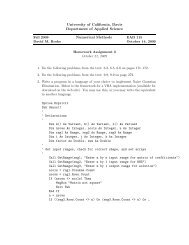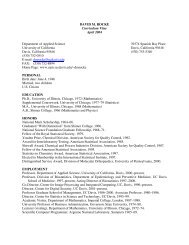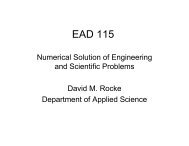Transformation and normalization of oligonucleotide microarray data
Transformation and normalization of oligonucleotide microarray data
Transformation and normalization of oligonucleotide microarray data
You also want an ePaper? Increase the reach of your titles
YUMPU automatically turns print PDFs into web optimized ePapers that Google loves.
S.C.Geller et al.only 8339 <strong>of</strong> the 12 625 genes (or <strong>of</strong> the 11 970 genes <strong>of</strong> the<strong>data</strong> subset) were usable as the other approximately 30% <strong>of</strong>the <strong>data</strong> had one or more <strong>of</strong> the replicates with non-positivevalues. Omission <strong>of</strong> such a large amount <strong>of</strong> <strong>data</strong> is not optimal.Even if it is considered that these <strong>data</strong> are unimportant in thissample, since the genes are not expressed at a high level, comparison<strong>of</strong> different conditions is made much more difficult ifa gene is expressed at a low level in one sample <strong>and</strong> a highlevel in another. Simply replacing negative estimated expressionvalues by some arbitrary positive value such as 10 or 20,or by an estimated mean, is also non-optimal since it distortsthe variability pattern <strong>of</strong> the <strong>data</strong>.4 TRANSFORMATION AND NORMALIZATIONThe approach we pursue is to formulate a model that fits thevariance patterns in the <strong>data</strong>, <strong>and</strong> that contains <strong>normalization</strong>constants, <strong>and</strong> then use a procedure that can simultaneouslydetermine the transformation parameter <strong>and</strong> the <strong>normalization</strong>.The statistical model used is that, for gene i <strong>and</strong> chip j,the measured (average difference) value y ij satisfiesf c (y ij ) = µ i + n j + ɛ ij ,where µ i is the true expression <strong>of</strong> gene i in the sample, n j is anadditive chip <strong>normalization</strong>, <strong>and</strong> ɛ ij is an additive symmetricmeasurement error.The back-transformed, normalized measurementsỹ ij = fc−1 [f c (y ij ) − n j ]+αare assumed to fit the two-component model, so thatV(ỹ ij ) = σ 2 ɛ + S2 η µ2 i .In this model, Sη 2 = eσ η 2 (eση2 − 1), which is to the first orderthe same as ση 2. For example, if σ η = 0.1, corresponding to a10% coefficient <strong>of</strong> variation, then S η = 0.1008.The transformation used is[ √]f c (y) = ln y − α + (y − α) 2 + c ,where c = σɛ 2/S2 η , or equivalently to the first order c =σɛ 2/σ η 2 . Note that we could treat α as negligible given that theprimary <strong>data</strong> are PM–MM, which can be presumed to have amean near zero for unexpressed genes, but actually estimatedall the values, including α. We will briefly examine the result<strong>of</strong> keeping α = 0. We can estimate σɛ2 from the low level<strong>data</strong> <strong>and</strong> ση 2 from the high level <strong>data</strong>, as in Rocke <strong>and</strong> Durbin(2001), but the values <strong>of</strong> σˆη , σˆɛ , <strong>and</strong> c are interdependent in thesense that we cannot determine σˆη <strong>and</strong> σˆɛ without knowing c,<strong>and</strong> vice versa. We solve this problem using the followingiteration:1. Starting with a trial value <strong>of</strong> c, transform the <strong>data</strong> using[ √]f c (y ij ) = ln y ij −ˆα + (y ij −ˆα) 2 + c .(We could use ˆα = 0 for these average difference <strong>data</strong>or estimate it.)2. Determine the <strong>normalization</strong> constants n j by taking themedian <strong>of</strong> all genes over each slide minus the median<strong>of</strong> all the genes on all the slides. Then, the transformed,normalized <strong>data</strong> aref c (y ij ) − n j .3. Back-transform the normalized transformed valuesusing the inverse transformationfc−1 (z) = ez − ce −z+ˆα.24. Determine the parameters σ ɛ <strong>and</strong> σ η <strong>of</strong> the twocomponentmodel by pooling low <strong>and</strong> high levels <strong>of</strong>expression as given in the Appendix <strong>and</strong> re-estimate α,a step not necessary when assuming that α = 0. We usea fixed number <strong>of</strong> genes at the high end, <strong>and</strong> at the lowend use all genes whose medians are sufficiently closeto α.5. Determine a new transformation parameter c = σɛ 2/σ η 2,<strong>and</strong> return to step 1 (using the original <strong>data</strong> not the backtransformed<strong>data</strong>).6. Stop the process when the parameter values stopchanging.For this application, we did not assume that the averagedifference scores <strong>of</strong> unexpressed genes average out to nearzero, so that α is estimated, rather than assumed to bezero. We check out the effects <strong>of</strong> assuming α = 0 below.We estimated σ η by pooling IQRs <strong>of</strong> the log transformed<strong>data</strong> corresponding to the highest h <strong>of</strong> the medians <strong>of</strong> the logtransformed <strong>data</strong> (see appendix). Also note that we cannotdetermine the transformation accurately without the iterative<strong>normalization</strong>. In our <strong>data</strong> the flask effects (flask medianminus overall median) on the transformed scale ranged from1/4 to 3/4 <strong>of</strong> a robust estimate <strong>of</strong> the st<strong>and</strong>ard deviation <strong>of</strong> theerrors, so would have affected our computation <strong>of</strong> c.The above procedure was applied to the autism <strong>data</strong>. Itconverged after 25 iterations to c = 4300 (from σ ɛ =8.20 <strong>and</strong> σ η = 0.125 with α = 2.74 <strong>and</strong> h = 125).Figure [ 3 is a graph <strong>of</strong> the transformation, f 4300 (y) =ln y − 2.74 + √ ](y − 2.74) 2 + 4300 , over the range <strong>of</strong> the<strong>data</strong> with a graph (dotted line) <strong>of</strong> z = ln [2(y − 2.74)], theequivalent log transform, for comparison. Figure 4a <strong>and</strong> b1820


